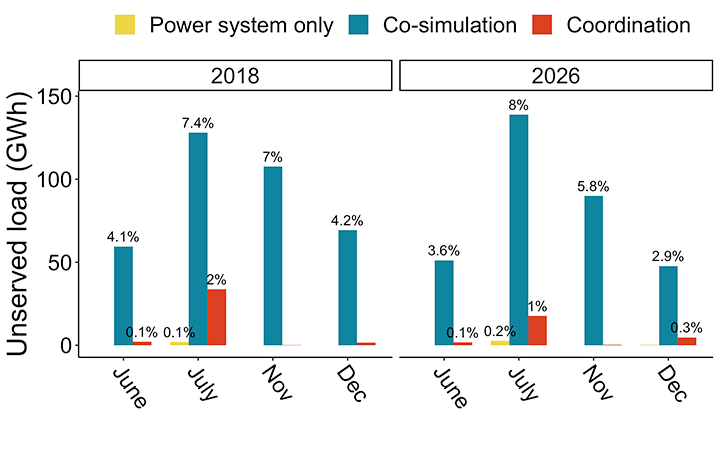Coordinated System Could Sync Up Natural Gas and Electric Sectors

Photo provided by Kinder Morgan, Inc.
Update to story: The final publication in the series has been published, providing practical implementation for natural gas-electric system coordination.
September 22, 2020—Natural gas and electricity are becoming increasingly interdependent, introducing new complexities. As natural gas provides more power to the U.S. energy grid, greater flexibility and better coordination between the two sectors will be required.
This is the top takeaway from a series of studies performed by the Joint Institute for Strategic Energy Analysis (JISEA) on the natural gas-electricity interface. JISEA analysts Omar J. Guerra, Brian Sergi, and Bri-Mathias Hodge partnered with academia and commercial energy system modelers, along with from a diverse consortium of sponsoring organizations.
Using Colorado power and gas pipeline data provided by Kinder Morgan, Inc., the analysts studied operational costs and power reliability of a coordinated, market-based natural gas-electricity system. Their findings are published in the JISEA technical report Electric Power and Natural Gas Network Operations and Coordination. High-level insights from the report are published in a special JISEA Research Highlight.
The Natural Gas System Adjusts as the Power Grid Evolves
Kinder Morgan's Colorado Interstate Gas system has successfully served Colorado for decades. With the growth of natural gas as a fuel source for electricity and the increasing penetration of renewables on the power grid, the Colorado gas system has adjusted operations. This includes new infrastructure, services, and contracts.
While the Colorado gas pipeline has been able to meet varying demands, natural gas system operators face many challenges as the power grid evolves, including conflicting natural gas-electric system operations, contracting, and sensors and communications. These factors can impact power supply, which has jumpstarted interest in a new, coordinated system.
System Coordination Relieves Challenges
The JISEA analysts studied a proposed framework that allows the natural gas and electric systems to exchange information such as gas demand from generators or availability from the gas network. Their findings show coordination can have many benefits, and ultimately, enable more reliable, affordable electricity.
In this study, coordinated operation of gas and power systems reduced gas curtailment and unserved natural gas by almost 97% for the Colorado system. This included coordination at multiple timescales, ranging from day-ahead to real-time to intra-day, as proposed by FERC Order 809, which was the focus of a previous report in the series of natural gas-electricity studies conducted by JISEA.
The reduction in gas curtailment and unserved natural gas was particularly true for high-demand times like summer, when curtailment would normally require costly, out-of-market manual interventions by system operators. The study finds $1.7 million in revenue for natural gas operators in the four highest demand weeks of the year in Colorado.

The total unserved load—power generation that can't be delivered because of gas constraints and must be met with manual operator intervention—is compared for three modeled future scenarios, from the least to the most integrated natural gas-electric systems. In every month except July, the unserved load during the week selected for the study is less in 2026 versus 2018. The bars with no percentages are less than 0.1% unserved load.
The weekly share of unserved load or unmet demand—power generation that can't be delivered because of gas constraints and must be met with manual operator intervention—is compared for three modeled future scenarios, from the least to the most integrated natural gas-electric systems. In every month except July, the unserved load during that week is less in 2026 versus 2018. The bars with no percentages represent less than 0.1% unserved load.
System Coordination Supports Increased Renewables
The study results indicate natural gas-electric coordination would facilitate higher levels of renewable penetration on the U.S. electricity grid. Based on the modeled scenarios, system coordination can alleviate natural gas pipeline constraints and provide greater flexibility for natural gas to serve as a key backup power source when generation is not available with intermittent renewable energy sources like wind or solar power.
The analysts recognize that creating an integrated system doesn't happen overnight. It would require new physical capabilities of pipelines, operational procedures, sensors and communications, and contracting. Furthermore, the benefits of coordination are likely to vary based on the characteristics of the system, including the pipeline network, composition of the generation fleet, and demand for electricity and gas.
Still, the analysts' findings suggest that for many systems, the investment in greater coordination would likely be well worth the outcome.
This study was led by Omar J. Guerra, Brian Sergi, and Bri-Mathias Hodge from the National Renewable Energy Laboratory with partners from the University of Michigan and encoord.
This study was sponsored by a consortium of organizations including Kinder Morgan, Inc., Midcontinent Independent System Operator, Hewlett Foundation, Environmental Defense Fund, American Gas Association, and American Electric Power.
For more information, read the full report.
Back to JISEA News >
